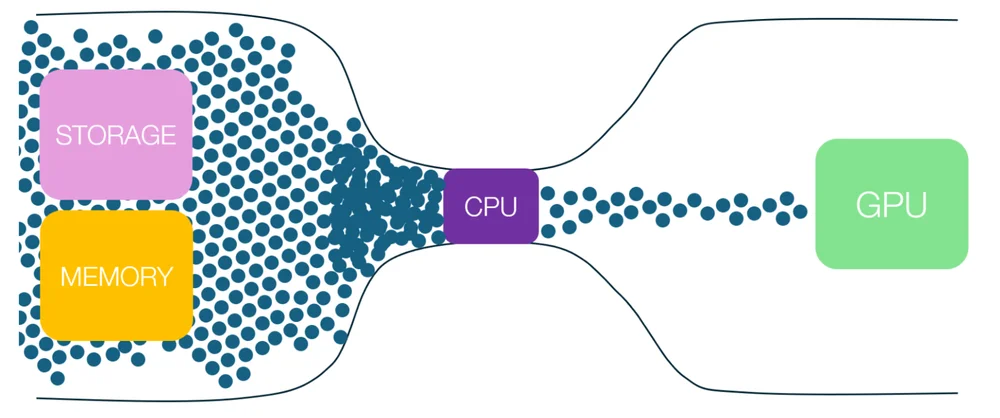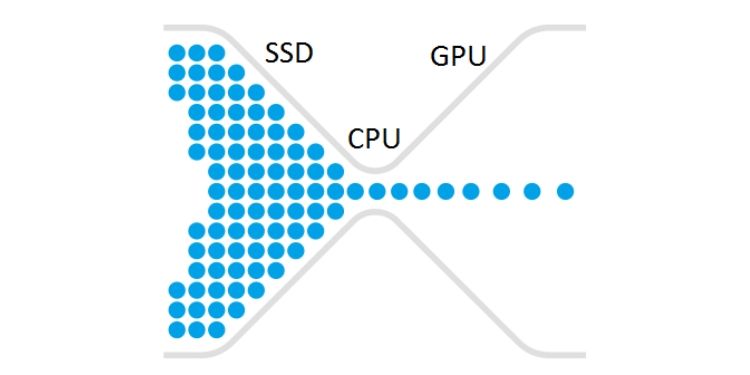When building or upgrading a PC, one of the most common concerns for gamers, content creators, and PC enthusiasts in the USA is whether their processor (CPU) will bottleneck their graphics card (GPU).
Yes, your processor can bottleneck your GPU if it’s too weak, limiting performance. Check CPU and GPU usage to identify imbalances. Pair compatible components to avoid bottlenecks for smooth gaming or tasks.
In this article, we’ll explore what a CPU-GPU bottleneck is, how to identify it, and how to ensure your processor and graphics card work harmoniously to deliver optimal performance.
With a focus on practical advice and real-world scenarios, this guide will help you make informed decisions about your PC build.
Understanding CPU-GPU Bottlenecks
A bottleneck happens when the CPU cannot process data fast enough to keep up with the GPU, or vice versa. In a CPU bottleneck, the processor struggles to handle tasks like game logic, AI calculations, or physics simulations, causing the GPU to wait for instructions. This results in lower frame rates, stuttering, or underutilized GPU performance. Conversely, a GPU bottleneck occurs when the graphics card is the limiting factor, often in scenarios requiring high graphical fidelity, such as 4K gaming or ray tracing.
The likelihood of a CPU bottlenecking a GPU depends on several factors, including the specific CPU and GPU models, the workload (e.g., gaming, video editing, or streaming), and the resolution at which you’re operating. For example, at lower resolutions like 1080p, games tend to be more CPU-intensive because the GPU can render frames quickly, putting more pressure on the CPU to keep up. At higher resolutions like 4K, the GPU becomes the limiting factor, reducing the chance of a CPU bottleneck.
Common Scenarios Where Bottlenecks Occur

To understand whether your processor will bottleneck your GPU, consider the following scenarios:
- Gaming at 1080p with a High-End GPU: If you pair a powerful GPU like the NVIDIA RTX 4090 with an older or mid-range CPU like an Intel Core i5-9400F, the CPU may struggle to process game logic fast enough. This is especially true in CPU-heavy games like Cyberpunk 2077 or Assassin’s Creed Valhalla, where tasks like NPC behavior and physics calculations demand significant CPU power.
- Content Creation and Multitasking: For tasks like video editing, 3D rendering, or streaming, a weak CPU can limit performance even with a high-end GPU. Software like Adobe Premiere Pro or Blender relies heavily on the CPU for encoding and processing, meaning an underpowered processor could slow down your workflow.
- Older CPUs with Modern GPUs: Upgrading your GPU without upgrading your CPU can lead to bottlenecks. For instance, pairing a Ryzen 3 1200 (released in 2017) with an AMD RX 7800 XT may result in the CPU being unable to keep up, especially in modern titles or multitasking scenarios.
- Esports Titles and High Refresh Rates: Competitive games like Valorant or CS2 are often lightweight on the GPU but demand a fast CPU to achieve high frame rates (e.g., 240 FPS or higher) for 144Hz or 240Hz monitors. A slower CPU could cap your frame rates, even with a capable GPU.
How to Identify a Bottleneck
To determine if your CPU is bottlenecking your GPU, you can monitor system performance using tools like MSI Afterburner, HWMonitor, or Task Manager. Here’s how to check:
- GPU and CPU Usage: Run a game or application and observe the usage percentages. If your GPU usage is consistently below 90-100% while your CPU is at or near 100%, your CPU is likely the bottleneck. Conversely, if the GPU is maxed out and the CPU has headroom, the GPU is the limiting factor.
- Frame Rate Analysis: If your frame rates are lower than expected for your GPU’s capabilities, or you experience stuttering, a CPU bottleneck could be the culprit. Tools like CapFrameX can help analyze frame times and identify inconsistencies.
- Benchmarking: Run benchmarks like 3DMark or Cinebench to compare your CPU and GPU performance against similar systems. Significant deviations from expected scores can indicate a bottleneck.
Factors to Consider When Pairing a CPU and GPU
To avoid bottlenecks, it’s essential to choose a CPU and GPU that complement each other. Here are key factors to consider:
- Workload Type: Identify your primary use case. For gaming, prioritize a CPU with strong single-threaded performance (e.g., AMD Ryzen 7 7800X3D or Intel Core i7-14700K). For content creation, opt for a CPU with more cores and threads (e.g., AMD Ryzen 9 7950X or Intel Core i9-14900K).
- Resolution and Settings: Higher resolutions (1440p or 4K) shift the workload to the GPU, reducing the CPU’s impact. If you game at 1080p, invest in a stronger CPU to avoid bottlenecks.
- Budget Balance: Allocate your budget to balance CPU and GPU performance. Spending too much on a GPU and skimping on the CPU can lead to bottlenecks. For example, pairing an RTX 4080 with a budget CPU like the Intel Core i3-12100 may limit performance in CPU-intensive tasks.
- Future-Proofing: Modern games and applications are increasingly multithreaded, so choosing a CPU with 6-8 cores (e.g., AMD Ryzen 5 7600X or Intel Core i5-14600K) ensures longevity. Similarly, a mid-to-high-end GPU like the NVIDIA RTX 4070 or AMD RX 7900 XT can handle future demands.
Recommended CPU-GPU Pairings for 2025
Based on current hardware trends in the USA, here are some balanced CPU-GPU pairings to minimize bottlenecks across different budgets:
- Budget Build (~$500-$700):
- CPU: AMD Ryzen 5 5600X or Intel Core i5-12400F
- GPU: NVIDIA RTX 3060 or AMD RX 7600
- Use Case: 1080p gaming, light content creation
- Why It Works: These CPUs offer strong single-threaded performance and enough cores for modern games, while the GPUs deliver solid 1080p performance without overwhelming the CPU.
- Mid-Range Build (~$800-$1200):
- CPU: AMD Ryzen 7 7700X or Intel Core i5-14600K
- GPU: NVIDIA RTX 4070 Ti or AMD RX 7900 XT
- Use Case: 1440p gaming, streaming, video editing
- Why It Works: The CPUs provide excellent multithreaded performance for gaming and productivity, while the GPUs handle high-resolution gaming and ray tracing effectively.
- High-End Build (~$1500-$2000):
- CPU: AMD Ryzen 9 7950X3D or Intel Core i7-14700K
- GPU: NVIDIA RTX 4090 or AMD RX 7900 XTX
- Use Case: 4K gaming, professional content creation
- Why It Works: These CPUs offer top-tier performance for any workload, ensuring the high-end GPUs are fully utilized even in demanding scenarios.
Tips to Mitigate or Prevent Bottlenecks

If you suspect a bottleneck or want to optimize your system, consider these strategies:
- Overclocking: If your CPU supports overclocking (e.g., Intel “K” series or AMD Ryzen with Precision Boost Overdrive), you can squeeze out extra performance to reduce bottlenecks. Ensure proper cooling to avoid thermal throttling.
- Update Drivers and BIOS: Outdated drivers or BIOS can cause performance issues. Regularly update your GPU drivers (via NVIDIA GeForce Experience or AMD Adrenalin) and check for motherboard BIOS updates.
- Optimize Game Settings: Lowering CPU-intensive settings like draw distance, NPC density, or physics effects can reduce the load on your processor, helping balance performance.
- Upgrade Strategically: If your CPU is significantly older than your GPU, consider upgrading to a modern processor. Platforms like AMD AM5 or Intel LGA 1700 offer upgrade paths for future CPUs, ensuring longevity.
- Monitor Background Processes: Close unnecessary applications while gaming or working to free up CPU resources. Tools like Task Manager can help identify resource-hogging programs.
FAQs
How do I tell if my CPU will bottleneck my GPU?
Monitor usage: if CPU hits 100% while GPU is below 90%, your CPU may bottleneck. Use tools like MSI Afterburner.
How do I tell if my CPU can handle my GPU?
Check CPU-GPU benchmarks online. Ensure your CPU’s core count and speed match your GPU’s demands for balanced performance.
Does your CPU affect your GPU?
Yes, a weak CPU can limit GPU performance, causing lower frame rates or stuttering in games and tasks.
Is it possible for a GPU to bottleneck a CPU?
Yes, a weak GPU can bottleneck a CPU, especially at high resolutions, limiting overall system performance.
What are the best CPU and GPU combos?
Pair mid-range like Ryzen 5 5600X with RTX 3060, or high-end like Ryzen 9 7950X with RTX 4090.
How do I know if my CPU is better than my GPU?
Compare benchmark scores on sites like PassMark. Higher CPU scores than GPU suggest CPU outperforms GPU.
Conclusion
To avoid CPU-GPU bottlenecks, pair compatible components based on your workload and resolution. Monitor usage, optimize settings, and upgrade strategically. Balanced builds, like Ryzen 7 7800X3D with RTX 4080, ensure smooth, future-proof performance for gaming and productivity.











